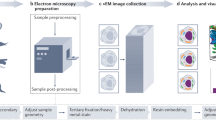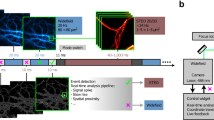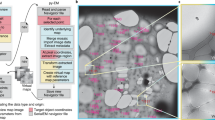Abstract
ELECTRON micrographs may be considered analogous to X-ray pictures, since the darkness and brightness depend on the thickness and density of the specimen; they are unlike micrographs taken with the light microscope, in which an image is formed due to differences in the amount of absorption or refraction within the object. The presence of very small particles in specimens for examination under the electron microscope will cause perceptible scattering, and the image formed of an object thicker than about 0·5 µ is merely an enlarged silhouette.
This is a preview of subscription content, access via your institution
Access options
Subscribe to this journal
Receive 51 print issues and online access
$199.00 per year
only $3.90 per issue
Buy this article
- Purchase on Springer Link
- Instant access to full article PDF
Prices may be subject to local taxes which are calculated during checkout
Similar content being viewed by others
References
Trans. Amer. Inst. Elect. Eng., April 1940.
Stanley, W. M., and Anderson, T. F., J. Biol. Chem., 146, 25 (1942).
Morton, H. E., and Anderson, T. F., Proc. Soc. Exp. Biol. (N.Y.), 46, 272 (1941).
Mudd, S., and Anderson, T. F., J. Exp. Med., 76, 103 (1942).
Mudd, S., Amer. J. Publ. Health, 33, 167 (1943).
Mudd, S., Polevitzky, K., and Anderson, T. F., Arch. Path., Chicago, 34, 199 (1942).
Morton, H. E., and Anderson, T. F., J. Bact., 45, 143 (1943).
Sheffield, F. M. L., School Sci. Rev., 25, No. 96, 201 (1944).
Anderson, T. F., and Stanley, w. M., J. Biol. Chem., 139, No. 1, 339 (1941).
Green, R. H., Anderson, T. F., and Smadel, J. E., J. Exp. Med., 75, No. 6, 651 (1942).
Sharp, D. G., Taylor, A. R., Beard, Dorothy, and Beard, J. W., Proc. Soc. Exp. Biol. and Med., 50, 205 (1942); 51, 205(1942); 51, 332 (1942).
Chambers, L. A., and Henle, W., J. Exp. Med., 77, 251 (1943).
Chambers, L. A., Henle, W., Lauffer, M. A., and Anderson, T. F., J. Exp. Med., 77, 265 (1943).
Plotz, H., Smadel, J. E., Anderson, T. F., and Chambers, L. A., J. Exp. Med., 77, 355 (1943).
Luria, S. E., and Anderson, T. F., Proc. U.S. Nat. Acad. Sci., 28, No. 44, 127 (1942).
Hall, C. E., Jakus, M. A., and Schmitt, F. O., J. Amer. Chem.Soc, 64, 1234 (1942).
Richards, jun. A. Glenn, and Anderson, T. F., J. Morph., 71, No. 1, 135 (1942).
v. Ardenne, M., Z. Phys., 115, 339 (1940).
v. Ardenne, M., Z. Phys., 112, 744 (1939).
Scherzer, O., Z. Phys., 114, 427 (1939).
Rights and permissions
About this article
Cite this article
DONOVAN, G. Biological Applications of the Electron Microscope*. Nature 154, 356–358 (1944). https://doi.org/10.1038/154356a0
Issue Date:
DOI: https://doi.org/10.1038/154356a0
Comments
By submitting a comment you agree to abide by our Terms and Community Guidelines. If you find something abusive or that does not comply with our terms or guidelines please flag it as inappropriate.



